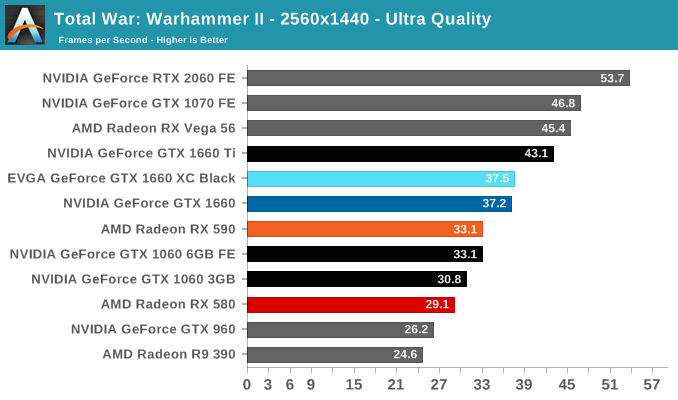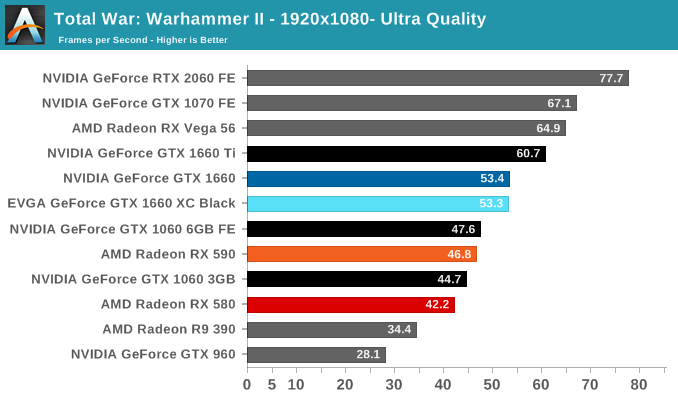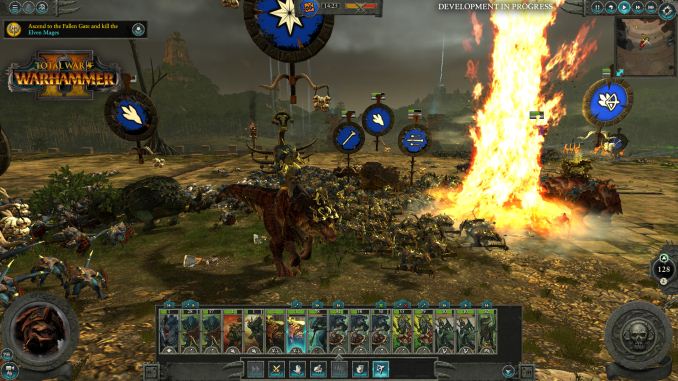The NVIDIA GeForce GTX 1660 Review, Feat. EVGA XC GAMING: Turing Stakes Its Claim at $219
by Ryan Smith & Nate Oh on March 14, 2019 9:01 AM ESTTotal War: Warhammer II (DX11)
Last in our 2018 game suite is Total War: Warhammer II, built on the same engine of Total War: Warhammer. While there is a more recent Total War title, Total War Saga: Thrones of Britannia, that game was built on the 32-bit version of the engine. The first TW: Warhammer was a DX11 game was to some extent developed with DX12 in mind, with preview builds showcasing DX12 performance. In Warhammer II, the matter, however, appears to have been dropped, with DX12 mode still marked as beta, but also featuring performance regression for both vendors.
It's unfortunate because Creative Assembly themselves have acknowledged the CPU-bound nature of their games, and with re-use of game engines as spin-offs, DX12 optimization would have continued to provide benefits, especially if the future of graphics in RTS-type games will lean towards low-level APIs.
There are now three benchmarks with varying graphics and processor loads; we've opted for the Battle benchmark, which appears to be the most graphics-bound.


Rounding out our look at game performance is Total War: Warhammer II. Here, the GTX 1660 is a neat split between the GTX 1060 6GB/RX 590 and the GTX 1660 Ti.











77 Comments
View All Comments
Qasar - Sunday, March 17, 2019 - link
ebay is not really an answer, as some.. may not want to deal with the hassle of ebay, or even have an ebay account. and now a days, not all games can be resold. but that still doesnt add any " value " to the video card by adding specific games...romrunning - Thursday, March 14, 2019 - link
Triple-slot coolers pretty much kill it for mini-ITX systems. Usually they only have room for double-slot at most.damianrobertjones - Thursday, March 14, 2019 - link
Second hand 1070 all... day... long.TheCurve - Thursday, March 14, 2019 - link
Great review guys, loved it!Tilmitt - Thursday, March 14, 2019 - link
If you actually want these reviews to be useful to real people making actual upgrade decisions, you need to include far more older GPUs. All the mid and high end GPUs from the 700 and 900 series at least. Preferably an awful lot more than this.Ryan Smith - Thursday, March 14, 2019 - link
It's always a fine balance between including older cards for context, and newer cards to showcase how it actually compares to other things you can buy (and the product it directly replaces). In this case we do have the GTX 960 and the R9 390 in these graphs; meanwhile for everything else, Bench can give you whatever comparisons you're looking for.https://www.anandtech.com/bench/GPU18/2293
Tilmitt - Friday, March 15, 2019 - link
Unless I'm doing it wrong, bench is useless because the cards people want to compare aresegregated into different bench years so you can't actually compare them. How does one compare a 770 and a 1660?
Ryan Smith - Friday, March 15, 2019 - link
Fair enough point on the Kepler cards. We haven't gone in and backfilled those yet. However all of the 900 series cards are in there.Hrel - Tuesday, March 19, 2019 - link
Doesn't seem to be any way to compare the R9 280x to the 1660 either, or the GTX1070.zeroidea - Monday, March 18, 2019 - link
If all the benchmark data is in a database, might it be possible to make the charts dynamic, and have an "add card to this graph" option? Better yet, store a user's personal system (or import it from pcpartpicker) and do this automatically for logged-in users, since this is what a lot of people care about (and currently open multiple tabs to different websites in order to accomplish the same thing). That's the kind of value-add that'd get me to cough up a bit for a premium membership, if AT ever wanted to go down that route.